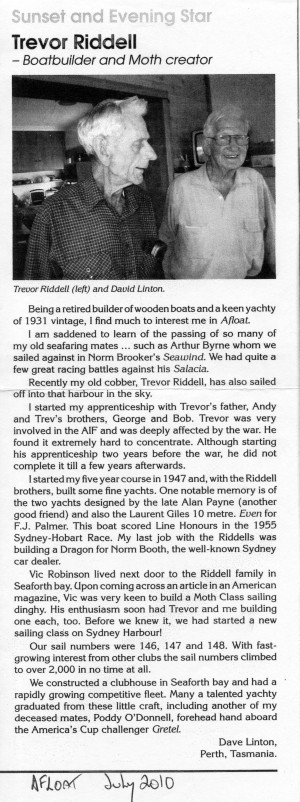| Moth | |
|---|---|
| LOA | 3.35m, 11f |
| Beam | 2.25m, 7.38f |
| Website | en.wikipedia.org/wiki/Moth_(dinghy) www.moth.asn.au/moth-info/profile |
Moth
From www.moth.asn.au - International Moth Class Association of Australia
The International Moth is an eleven foot long, high performance, single handed racing dinghy. We are proud to be one of the few development classes left in the world and have very few design rules including no weight limit. We encourage innovation just as much as we encourage sailing skill. We welcome home boat building and wacky designs, and almost importantly, we welcome unconventional people with open arms. This offical Australian Moth web site has all the latest National information that you need to start Mothing right now.
Length overall 3.355 m
Beam 2.250 m
Max. luff length 5.185 m
Max. mast length 6.250 m
Hull weight Unrestricted, general weight range 10-20kgs
Rigged Weight as little as 26kgs
Sail area 8m
Restrictions Multihulls, trapezes, moveable seats and sailboards are prohibited.
Optimum skipper weight 60-80kgs
Advertising Category C (unrestricted)
Trevor Riddell - Boat Builder and Moth Creator
Afloat 2010
Being a retired builder of wooden boats and a keen yachty of 1931 vintage, l find much to interest me in Afloat.
l am saddened to learn of the passing of so many of my old seafaring mates such as Arthur Byrne whom we sailed against in Norm Brooker's Seawind. We had quite a few great racing battles against his Salacia.
Recently my old cobber, Trevor Riddell, has also sailed off into that harbour in the sky.
I started my apprenticeship with Trevor's father, Andy and Trev's brothers, George and Bob. Trevor was very involved in the AIF and was deeply affected by the war. He found it extremely hard to concentrate. Although starting his apprenticeship two years before the war, he did not complete it till a few years afterwards.
I started my five year course in 1947 and, with the Riddell brothers, built some fine yachts. One notable memory is of the two yachts designed by the late Alan Payne (another good friend) and also the Laurent Giles 10 metre. Even for F.J. Palmer. This boat scored Line Honours in the 1955
Sydney-Hobart Race. My last job with the Riddells was building a Dragon for Norm Booth, the well-known Sydney car dealer.
Vic Robinson lived next door to the Riddell family in Seaforth bay. Upon coming across an article in an American magazine, Vic was very keen to build a Moth Class sailing dinghy. His enthusiasm soon had Trevor and me building one each, too. Before we knew it, we had started a new sailing class on Sydney Harbour!
Our sail numbers were 146, 147 and 148. With fast-growing interest from other clubs the sail numbers climbed to over 2,000 in no time at all.
We constructed a clubhouse in Seaforth bay and had a rapidly growing competitive fleet. Many a talented yachty graduated from these little craft, including another of my deceased mates, Poddy O'Donnell, forehead hand aboard the America's Cup challenger Gretel.
Dave Linton,
Perth, Tasmania
Articles | Middle Harbour Regatta 1959 Middle Harbour Regatta 1959 - Moth Sailing Class The following is an excerpt from the Middle Harbour Regatta Program 1959 MOTH CLASS SAILING The Seaforth Moth Sailing Club was the first Moth Club in New South Wales and held its first race at Seaforth Bay in September 1952 with six starters. Since then the Club has steadily grown and now has its own Clubhouse at Seaforth that houses twenty-two Moths. The season is from early September through to late April each year and the standard of sailing is always high. This season members of the Club already hold the Australian, State, Lane Cove and Pittwater Championships. Balmoral Moth Sailing Club, not as old as Seaforth, has over sixty Moths registered, the biggest fleet in Australia. With their Clubhouse situated at an ideal location on Balmoral Beach, it is the centre of the social functions connected with the Moth Class. The class is widely represented throughout the world and is subject to the following restrictions: . Length: No more than 11ft, no less than 10ft. Mast: No higher than 20ft. 6in. above the deck. ' Sail: No larger than 80 square feet. These measurements allow scope for innovations and experiments in design. Each boat, mast and sail must be measured before competing in Club or inter-Club races and is then registered with the New South Wales Moth Class Sailing Association who allot a number. This number is stencilled on the sail together with the Moth insignia for easy recognition. In addition to races run weekly by the various clubs on their own courses, inter-Club and Association events are held on courses from Pittwater to Broken Bay, the majority on Sydney Harbour and its estuaries. Hulls are normally of plywood construction and weight varies from 65lbs. to 130lbs. Boats can be easily carried by two youngsters and transported on top of cars or on light trailers. Moths are particularly safe craft for beginners, the majority being Watertight and easily righted when capsized. Juniors of ten years of age with a senior to handle the sheet rope have no difficulty in sailing. Having only one sail they can be handled quite competently by one person in winds in excess of 30 m.p.h. Ages of those sailing boats regularly range from 12 to 45 years. Moths are becoming increasingly popular and offer a method of teaching youngsters from the age of 10 or 11 years to sail, developing their initiative and enabling a considerable number of people to enjoy the advantages of the open air and the exhilaration of controlling a fast-moving boat on our beautiful coastal waters. The illustration is of the Australian champion, John Henderson, of Seaforth Club, sailing his boat Nil Desperandum, Number 353. |



